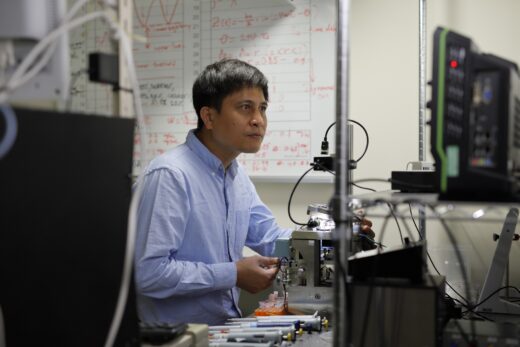
Kien Xuan Ngo, Asst. Prof., Nano Life Science Institute (WPI-NanoLSI), Kanazawa University
Kien Xuan Ngo is member of Toshio Ando’s Nanometrology group at the Kanazawa NanoLSI. “My expertise is in biochemistry and biophysics,” says Ngo. “I started my research career synthesizing nano-particles such as liposomes and micelles for biomedicine. Recently, I am focused on structural biology for clarifying the functions of cytoskeletal proteins—such as actin and microtubules—and so-called ‘ABC transporters’. In my research I combine my knowledge of biochemistry, biophysics, and mathematical simulations to address important problems in modern biology.”
Start of an international career in biochemistry
Ngo studied biochemistry at the Hanoi University of Agriculture, Vietnam, gaining valuable experience in isolating, screening, and manipulating microorganisms to kill harmful fungi that adversely affect crops and food. “After completing my undergraduate degree in 2000 I began to look for opportunities to study abroad,” explains Ngo. “I attended recruitment seminars in Hanoi given by university representatives from the USA, EU, and Japan. During one of these gatherings I met a professor from Osaka University who was recruiting students and described his university’s graduate school courses that were taught in English. Based on this meeting I decided to apply to study in Japan. This was the beginning of my journey that eventually led me to the NanoLSI.”
Ngo received a Vietnamese Government scholarship in 2003 to study for his master’s course at Osaka University’s Graduate School of Engineering Science. From 2005 he started doctoral research at Osaka University that was supported by a Vietnamese Government and the highly competitive JSPS DC1 scholarship.
During his doctorate Ngo worked on the design and fabrication of novel bio-catalysts based liposomes under the mentorship of Ryoichi Kuboi. “I focused on the chemical synthesis and self-assembly of amphiphilic biomolecules to explore their potential as bacterial cells in producing and recovering protein enzymes,” says Ngo. “My doctoral research was very fruitful. We published eight research articles in prestigious journals.”
After completing his doctorate in 2009 Ngo started his quest to hone his skills as a biochemist that would eventually lead him to the join the Kanazawa NanoLSI in April 2018. “I have been truly fortunate to have had the opportunity to work at some of the most advanced research institutions in the world with some of the most inspiring scientists in the world,” says Ngo. “I worked with Taro Uyeda at AIST (now at Waseda University) for five years and constructed recombinant proteins, reconstituted purified proteins in-vitro system, and examined the atomic-level properties of actin filaments; between 2011 and 2013, I joined Corinne Vebert-Nardin’s group at the University of Geneva to work on a project on the self-assembly of peptide-grafted ssDNA and chitosan-grafted ssDNA amphiphilic molecules in solution; and then in 2017 I spent a year at the Brain Science Research Institute, RIKEN (Wako) with Etsuko Muto working on real-time HS-AFM imaging of nucleation processes of tubulin during microtubule formation.”
Research in Japan and Switzerland
I have had the opportunity of working at AIST and RIKEN—two of Japan’s top research institutes. I found the people to be very focused and professional and they are excellent places to conduct research for young scientists like me. They have excellent facilities with advanced and reliable technology that enabled me to pick up critical skills and insights for my career in scientific research. At the University of Geneva I found that Switzerland is one of the happiest places in the world. People work seriously and enjoy life. Notably, most of the researchers at the university were from overseas; Geneva was a really diverse and international environment.”
Serendipity at the Kanazawa Bio-SPM Summer
Ngo’s initial interaction with AFM-researchers at Kanazawa University was at the Bio-AFM Summer School in 2013. “Just by chance, I attended the BIO-SPM Summer School at Kanazawa University and had the opportunity to learn first-hand how to use AFM technology for bio-imaging under the supervision of Noriyuki Kodera who was a member of Toshio Ando’s group.”
After the summer school, Ngo started to collaborate with the Ando Group on answering the question of whether actin filaments are rigid or dynamic and allosterically changeable. The joint research led to seminal publications in Elife 2015, and Scientific Reports 2016. “The collaboration with Professor Ando inspired me to apply for a position at the Kanazawa NanoLSI,” says Ngo. “My application was accepted, and I joined the group in April 2018. I am thoroughly enjoying my research at the NanoLSI.”
Future research vision
Ngo’s plans for the future include resolving fundamental questions about the differences in the behavior of single molecules and large ensembles of them. “I believe that scanning probing imaging technology at the NanoLSI will play a critical role in helping us find solutions to many of the basic questions in modern biology,” says Ngo. “As a NanoLSI researcher I am constantly combining my knowledge of biochemistry, nano scanning probing AFM microscopy, electron microscopy, and deep learning AI to address these issues. It’s a challenging but very satisfying area of interdisciplinary research.”
Research highlights: Cofilin binding to actins and action of toxins produced by plant pathogen fungi
Actin proteins are long filaments present in eukaryotic cells that help with the maintenance of cellular structure and are sources of forces necessary for cells to divide and move. Cofilin is a protein that binds with actin and affects how it transforms into filament structures. In a recent study, Ngo and his colleagues used high-speed atomic force microscopy imaging to directly visualize the dynamics of cofilin binding to actin filaments yielding unprecedented insights into cofilin-actin interaction that was not possible by conventional still imaging methods [1]. The main findings were the observation of actin filaments coated with cofilin being thicker than uncoated ones and cofilin reducing the “helical twist” of actin filaments.
Ngo and colleagues have also reported on the effects of cassiicolin—a toxin produced by the plant pathogen fungus corynespora cassiicola—on lipid membranes [2]. High speed AFM showed the binding and disruption action of Cas1 and Cas2 on depended on specific plant lipids. Ngo and co-researchers conclude that the “lipid-dependent toxicity of Cas toxins may be an important foundation to create highly tolerant rubber trees against fungal diseases.”
References
[1] Kien Xuan Ngo, Noriyuki Kodera, Eisaku Katayama, Toshio Ando, Taro QP Uyeda Cofilin-induced unidirectional cooperative conformational changes in actin filaments revealed by high-speed atomic force microscopy, eLife 4:e04806 (2015).
https://doi.org/10.7554/eLife.04806
[2] Kien Xuan Ngo et al, Unraveling the Host-Selective Toxic Interaction of Cassiicolin with Lipid Membranes and Its Cytotoxicity, Phytopathology, 112: 1524-1536, May 2022
https://doi.org/10.1094/PHYTO-09-21-0397-R
Further information
Asst. Prof. Kien Xuan Ngo’s episode on the NanoLSI Podcast.
Posted Mar. 15, 2023




